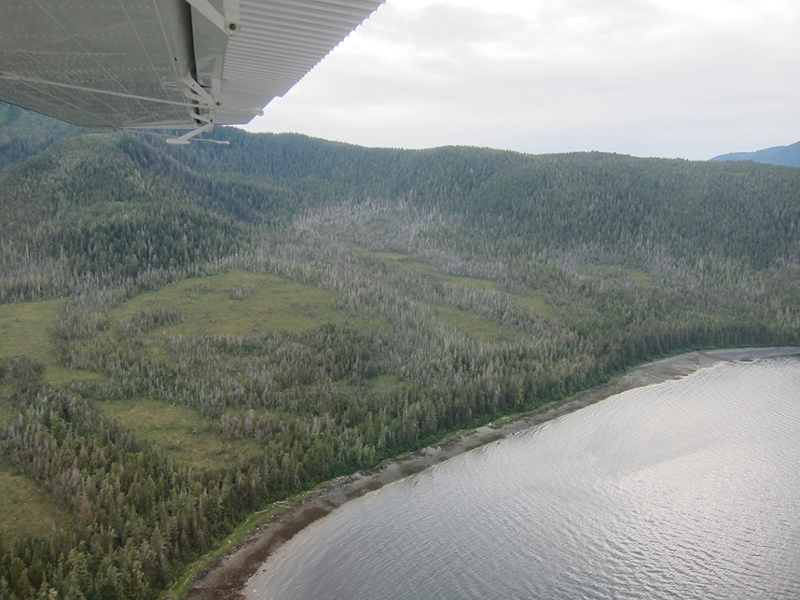Dead trees could bring new life to southeast Alaska lumber mills
Without an insulating blanket of snow, the shallow roots of yellow-cedar trees freeze during late spring cold snaps.
Juneau, Alaska
Date of Press Release: December 30, 2019

As climate change rapidly alters conditions in southeast Alaska, lower snowpack levels have caused a massive decline of yellow-cedar trees. Without an insulating blanket of snow, the shallow roots of yellow-cedar trees freeze during late spring cold snaps. Left behind is a growing expanse of “ghost forests” of dead yellow-cedars, affecting roughly 678,000 acres (nearly the area of Yosemite National Park). The decay-resistant properties of yellow-cedar allow the trees to remain standing for decades after death. ACRC director Allison Bidlack, and collaborators Brian Buma, Sarah Bisbing, and Brian Vander Naald, set out to determine whether these ghost stands might provide an economic opportunity for small lumber mills in Tongass National Forest.
The potential benefits of yellow-cedar salvage logging are numerous. As an alternate source of lumber, dead yellow-cedar could remove logging pressure on live trees and old-growth forests. It may also have a lesser impact on the surrounding ecosystem when removed, as dead yellow-cedar typically does not provide much wildlife habitat (aside from some use by nesting bats). Yellow-cedar’s decay-resistant properties give it natural value for outdoor materials like decks and playgrounds, where other types of wood must be chemically treated for the same use. As the harvest allowance of live trees is restricted and the timber industry in southeast Alaska continues to decline, an additional wood source could help sustain jobs at small, family-run logging and milling operations.
In reality, it’s more complicated. Because the dead tree stands are often scattered, remote, and more difficult to process, there can be higher logging and transportation costs with salvage logging. Access to quality dead tree stands through microsales is determined by the US Forest Service, and the supply can be inconsistent. And while live-harvest yellow-cedar lumber is sold widely in Asian markets, the market for dead tree rounds is not yet established.
Over several years, Bidlack and her colleagues met with researchers, agency managers, and mill operators to find out how dead yellow-cedar salvage could provide a profitable timber source for southeast Alaska mills. The researchers tracked operating cost and sales data from several small-scale lumber mills on Kupreanof and Prince of Wales islands. During the study, the scientists identified another problem in determining if this emerging enterprise is profitable: many of the mills had inaccurate cost tracking systems, making it hard to determine what the true costs and benefits associated with yellow-cedar salvage were. The revenue from salvaged yellow-cedar varied widely among mills in the study, as did the reported milling costs and product values.
Despite the lack of quality data on the harvesting and transporting costs and market value of yellow-cedar products, their findings showed that logging dead cedar stands can be profitable. In their recently published report, the authors found that the most common and most profitable use for salvaged yellow-cedar during the study was dimensional lumber, or wood cut into predefined, standard sizes. A few mills primarily used the lumber for firewood, which was the least profitable product created. But there may be a significant opportunity and profit in creating value-added specialty products with the salvaged wood, such as furniture, musical instruments, or specialty building materials.
“Our new climate reality, driving yellow-cedar mortality across much of the Tongass, presents an opportunity for a new approach to forest management and a forest products industry in southeast Alaska,” said Bidlack in the report.
Over the next 15 to 20 years, the US Forest Service will transition away from old-growth tree harvesting towards young-growth management and harvest in the Tongass. Mills will need to find alternate lumber sources during this transition. To sustain this emerging industry, access to quality dead tree stands through microsales and training opportunities for business owners to track and limit their costs are needed.
Learn more about Alaska Coastal Rainforest Center research at acrc.alaska.edu.
Additional Resources
Press Release Contact
Alaska Climate Adaptation Science Center / UAS Alaska Coastal Rainforest Center
(907) 796-6023
mdtankersley@alaska.edu